Neurology & Brain Health
Traumatic Brain Injuries and Neuroplasticity: Understanding the Brain's Ability to Recover

June 16, 2023
Brain Injury Association of California Team
This article explores the concept of neuroplasticity and how it plays a crucial role in the recovery process from a traumatic brain injury.
The human brain's ability to recover from injury is a testament to its remarkable adaptability. Central to this resilience is the concept of neuroplasticity - the brain's ability to reorganize itself by forming new neural connections throughout life. This article examines how neuroplasticity works and its implications for recovery from traumatic brain injuries (TBIs).
Neuroplasticity Defined
Neuroplasticity, also known as brain plasticity or neural plasticity, is the brain's ability to change and adapt as a result of experience. This includes creating new neural pathways and reorganizing existing ones to adjust to new information, development, learning, and recovery from brain damage.
Neuroplasticity and TBIs
When a TBI occurs, it can disrupt the brain's normal functions. Depending on the severity and location of the injury, symptoms can range from mild, temporary confusion to more serious, long-term cognitive or physical disabilities. Neuroplasticity plays a crucial role in recovery by helping the brain 'rewire' itself and compensate for any loss of function.
The Recovery Process
Following a TBI, the brain enters a period of spontaneous recovery, where neuroplastic changes can lead to improvements in physical and cognitive functions. This period can last for several months. After spontaneous recovery, further improvements can be made through targeted rehabilitation activities designed to promote neuroplasticity.
Promoting Neuroplasticity
Rehabilitation strategies that promote neuroplasticity can be crucial in the recovery process. These can include:
- Physical and Occupational Therapy: Engaging in repetitive, task-specific exercises can help retrain the brain and improve motor functions.
- Cognitive Therapy: Cognitive exercises can help improve memory, attention, and problem-solving skills.
- Speech-Language Therapy: This can assist with communication and swallowing issues that may occur after a TBI.
Conclusion
Understanding neuroplasticity is fundamental to understanding how recovery from a TBI is possible. While the process is complex and unique to each individual, the human brain's capacity to adapt and change gives hope for recovery and a return to functionality. By focusing on therapies that promote neuroplasticity, we can help those affected by TBIs to regain their independence and improve their quality of life.
Please note that this article is intended to provide general information. It should not be used as a substitute for professional medical advice.
Latest News
Understanding Brain Injuries: The Basics Everyone Should Know
An introductory guide to understanding the basics of brain injuries, including types, causes, symptoms, and treatments.
The Silent Epidemic: Raising Awareness about Traumatic Brain Injuries
This article highlights the need for increased awareness and understanding about traumatic brain injuries, often referred to as the 'silent epidemic.'
The Challenges of Rehabilitation after a Brain Injury
Learn about the various challenges individuals face during their rehabilitation journey after a brain injury, along with strategies to overcome these obstacles.
Brain Injuries in Children: How to Cope and What to Expect
A comprehensive guide for parents and caregivers to help navigate the difficult journey of a child's brain injury, from understanding its effects to developing coping strategies.
Mitigating the Effects of Brain Injuries through Nutrition
Learn how a balanced and nutritional diet can aid in the recovery and overall well-being of individuals with brain injuries.